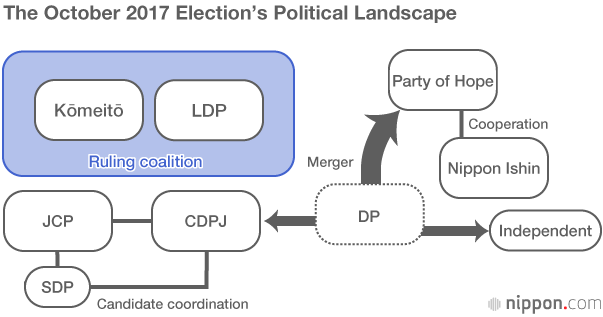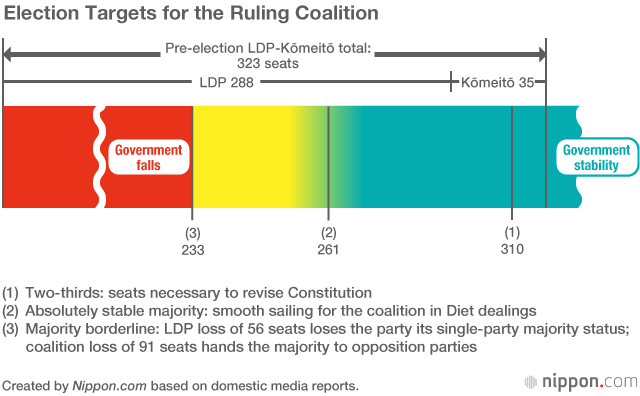Election Season Kicks Off: Parties Line Up for October 22 Contest
Newsfrom Japan
Politics- English
- 日本語
- 简体字
- 繁體字
- Français
- Español
- العربية
- Русский
On October 10, 2017, the campaigning officially kicked off for the House of Representatives election slated for October 22. So far the election has been spun primarily as a referendum on the performance of the administration of Prime Minister Abe Shinzō. The cards seem stacked against Abe’s Liberal Democratic Party and its coalition partner, Kōmeitō, in terms of extending their lead in the lower house, which currently stands at 323 of 475 seats.
This total will be reduced to 465 following redistricting aimed at addressing the disparity in the value of votes cast in urban and rural districts. The number of single-seat districts has been reduced by 6 to 289, and there will be 176 proportional representation seats, down 4 from their current number. The bare minimum majority level now stands at 233 seats in the lower house.
Attention has thus turned to whether the coalition will be able to hold on to 310 seats, the two-thirds mark required in both houses of the Diet to pass revisions to Japan’s Constitution; other targets being discussed are 261 seats, an “absolutely stable majority” level allowing the coalition to chair and maintain a majority of seats in all permanent lower house committees, and the “stable majority” level of 244 seats, which would allow the coalition to chair the committees and ensure at least parity with the opposition in committee membership numbers.
Toward a Tripolar Election
This month’s election features a dramatic shift in the political landscape, with the sudden appearance of Tokyo Governor Koike Yuriko’s Kibō no Tō, or Party of Hope, and the disintegration of the Democratic Party, with some members heading for Koike’s new group and others creating the Constitutional Democratic Party of Japan.
Maehara Seiji, the last leader of the DP, announced on September 28 that the party would field none of its own candidates in the upcoming contest. This was followed by efforts to arrange an effective merger with the Party of Hope, with the roughly 210 candidates that the leading opposition party planned to run taking the field under the Hope banner. These hopes were dashed when Koike’s new party stated that it would admit candidates as individuals, based on whether their views on security and other policy matters were in line with its platform. As of October 5, the Party of Hope had more than 200 candidates on its books ready to run, but just over 100 of these were former Democrats.
Meanwhile, DP Deputy President Edano Yukio on October 2 announced the launch of the new CDPJ. Left-of-center Democrats including former Prime Minister Kan Naoto and former Health Minister Nagatsuma Akira have flocked to its banner, and its membership has climbed to more than 70 likely electoral candidates.
The Party of Hope has agreed with Nippon Ishin (the Japan Innovation Party) to cooperate in the election, avoiding direct competition with each other’s candidates in districts in Tokyo and Osaka. The Japanese Communist Party, meanwhile, which is unable to field its own candidates in 67 of the 289 single-seat districts nationwide, has decided to “unify” its campaigning efforts with the CDPJ and Social Democratic Party, backing their candidates with similar policy stances.
These moves have produced a tripolar political battlefield, with the LDP-Kōmeitō coalition on one side, the Party of Hope and Nippon Ishin on the second, and the CDPJ, JCP, and SDP on the third.

The LDP on the Defensive?
The LDP enjoyed comfortable victories in the previous two lower house elections, held in December 2012 and December 2014. This time, though, the ruling party seems to be on the back foot, saddled by dismal support ratings for the Abe administration due to accusations that the prime minister wielded his influence to facilitate a discounted land sale to the Moritomo Gakuen school and to secure approval for a new veterinary college to be run by Kake Gakuen. (The operators of both schools are personally connected with Abe.) Add to this the popularity of Governor Koike and her new party and public dissatisfaction with Abe’s dissolution of the Diet and call for a snap election, and the ruling coalition appear to be on the defensive.
Prime Minister Abe has set the bar very low for calling this election a success, stating only that he aims to maintain at least a simple majority of 233 seats for the LDP-Kōmeitō coalition. Given the parties’ current standing, at 323 seats in the lower house, a result along these lines would almost certainly lead to calls for his resignation.

The general consensus is that the coalition must secure 311 seats, a two-thirds majority, to truly claim victory in the election. A step down from there is the 261-seat mark, which the coalition needs to reach to maintain its grip on the lower house committees. And if the LDP loses 50 or more seats, it will herald a dramatic drop in the political influence of its president, Prime Minister Abe.
Debate to Focus on Consumption Tax, Constitution
Prime Minister Abe claims that this election is needed to give the public a chance to weigh in on his proposal to earmark new revenues from the consumption tax, slated to rise from its current 8% to 10% in October 2019, for early childhood education and other child-rearing support measures. He has also touched on the threat of North Korea’s development of missile technology and nuclear weapons as a factor behind his calling of this snap election. Given the LDP’s inclusion of constitutional reform in its policy platform—specifically a rewriting of the war-renouncing Article 9 to clearly specify the Self-Defense Forces as Japan’s military—this has naturally brought the Japanese Constitution to the forefront of election debate alongside the consumption tax issues.
The LDP’s coalition partner is not quite so gung-ho on the question of rewriting Japan’s basic law. Kōmeitō’s own policy manifesto does include the reduction of education costs, though, and the junior partner is campaigning on pledges to make preschool education and tuition at private high schools effectively free of charge.
In the opposing camp, meanwhile, the Party of Hope is stressing the need to freeze the consumption tax at its current level. The newcomer is in favor of revising the Constitution, but has come out against the LDP’s proposals in this area. Also among its policy planks differentiating itself from the Liberal Democrats is the complete removal of nuclear power from the nation’s energy mix.
Nippon Ishin, the CDJP, and the Communists are all against further hikes to the consumption tax. The latter two are firmly opposed to making any adjustment to the Constitution. And the Party for Japanese Kokoro, expected to field a handful of candidates, wants Japan to craft an entirely new constitution and to strengthen its defense.
(Originally written in Japanese by the Nippon.com Editorial Department and published on October 10, 2017. Banner photo: Political party heads kick off election season with a debate on October 8 at the National Press Center in Tokyo. © Jiji.)
Koike Yuriko LDP Abe Shinzō constitution election JCP Party of Hope